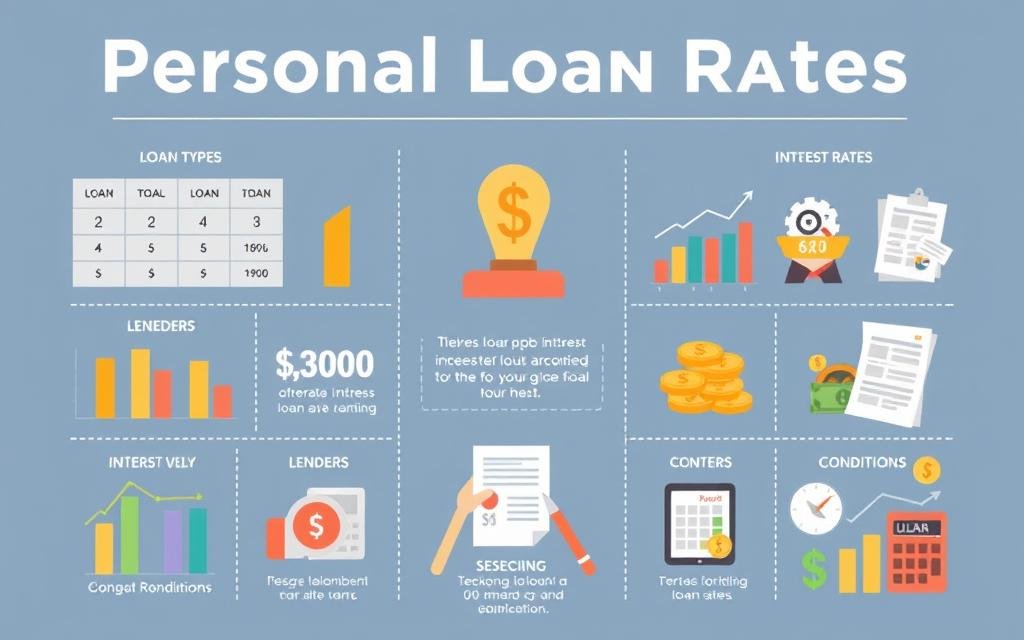
Looking for the right personal loan can seem overwhelming. But, there are lenders offering great rates and flexible terms. This guide will show you the best personal loans, top lenders, and what affects your rates and approval.
Personal loans are great for many needs, like paying off debt or buying something big. You can borrow from $2,000 to $50,000 with APRs as low as 7.80%. But, it’s important to think about loan amounts, repayment terms, and interest rates carefully.
What are Personal Loans and How Do They Work?
Personal loans give you a lump sum of money, usually between $1,000 and $100,000. You pay it back in fixed monthly payments over 2 to 7 years. They don’t need collateral, unlike secured loans, and are based on your credit score.
These loans are great for many needs, like paying off debt, fixing up your home, or covering big expenses. They’re a good option if you need money but don’t want to risk your assets.
To get a personal loan, lenders check your credit score, income, and debt-to-income ratio. A good credit score can help you get a lower interest rate. The best rates are for those with scores of 800 or higher.
| Credit Score Range | Average Personal Loan Interest Rate |
|---|---|
| 800 and above | Lowest interest rates, around 8% |
| 660-799 | Average interest rates, around 12-24% |
| Below 660 | Highest interest rates, around 24-36% |
Lenders might also charge an origination fee of up to 12%. This fee is taken out of the loan amount. So, it’s key to consider it when looking at the loan’s total cost.
Personal loans can be helpful if you need money fast and don’t have collateral. Knowing how they work and what affects your eligibility and rates can help you decide if they’re right for you.

Understanding Best personal loans Rates and Terms
When looking at personal loans, it’s key to know what affects the loan’s cost. The main things to look at are the loan amount, repayment terms, and interest rates.
Loan Amounts
Personal loans can range from $1,000 to $100,000. The amount you can get depends on your credit and financial situation. Lenders check your income, debts, and debt-to-income ratio to decide how much they can lend.
Repayment Terms
Repayment terms for personal loans can be from 2 to 7 years. Longer terms mean lower monthly payments but more interest paid over time. Shorter terms have higher monthly payments but less interest paid.
Interest Rates
Interest rates for personal loans vary from 7% to 36%. Your rate depends on your credit score, income, debt, and the lender. Those with high credit scores get the best rates, while poor credit scores lead to higher rates.
| Credit Score Range | Interest Rate Range |
|---|---|
| 720-850 (Excellent) | 10.73%-12.50% |
| 690-719 (Good) | 13.50%-15.50% |
| 630-689 (Fair) | 17.80%-19.90% |
| 300-629 (Poor) | 28.50%-32.00% |
Knowing about personal loan amounts, repayment terms, and interest rates helps you choose the best loan for you.

Top Lenders for Best Personal Loans
Finding the right personal loan can be tough. We’ve looked into the best options for you. These lenders offer great rates, flexible terms, and easy applications to meet your needs.
SoFi Personal Loans
SoFi is known for student loan refinancing but also offers personal loans. They provide loans from $5,000 to $100,000 with APRs from 8.99% to 29.99%. You can choose a repayment term from 2 to 7 years to fit your budget.
Upgrade Personal Loans
Upgrade is a fintech company that offers loans from $1,000 to $50,000. Their APRs range from 9.99% to 35.99%. They’re great for those with less-than-perfect credit. You can choose a repayment term from 2 to 7 years to match your financial goals.
LightStream Personal Loans
LightStream, a part of Truist Bank, is known for home improvement loans but also offers personal loans. They provide loans from $5,000 to $100,000 with APRs from 6.94% to 25.29%. You can choose a repayment term from 2 to 7 years to fit your budget.
| Lender | Loan Amounts | APR Range | Repayment Terms |
|---|---|---|---|
| SoFi | $5,000 – $100,000 | 8.99% – 29.99% | 2 – 7 years |
| Upgrade | $1,000 – $50,000 | 9.99% – 35.99% | 2 – 7 years |
| LightStream | $5,000 – $100,000 | 6.94% – 25.29% | 2 – 7 years |
These top lenders have a variety of personal loan options for you. Whether you need to consolidate debt, finance a big purchase, or cover an unexpected expense, they can help. They offer the best personal loan for your budget and timeline.
Factors that Affect Your Personal Loan Approval and Rates
When you’re looking for a personal loan, knowing what affects your approval and rates is key. Your credit score is very important. A higher score means lower interest rates. Lenders also check your income, debt, job, and credit history to decide if you’re a good borrower.
Your location and the loan’s amount and purpose also play a role. For instance, those with excellent credit scores (720-850) might get an APR of about 12.64%. But, those with good scores (690-719) could see rates around 14.84%. Fair credit scores (630-689) lead to rates of about 18.69%, and poor scores (300-629) face rates of about 21.74%.
The loan’s term also matters. Short-term loans, lasting four to five years, have higher monthly payments but lower interest rates. It’s crucial to find a repayment plan that fits your budget and keeps interest costs low.
| Credit Score Range | Estimated APR |
|---|---|
| 720 to 850 (Excellent) | 12.64% |
| 690 to 719 (Good) | 14.84% |
| 630 to 689 (Fair) | 18.69% |
| 300 to 629 (Poor) | 21.74% |
Understanding what affects personal loan approval and rates helps you make better choices. This way, you can get the best terms for your financial needs.
Tips for Getting the Best Personal Loan Rates
To get the lowest interest rate on a personal loan, we can take a few steps. First, we should check our credit report and try to improve our credit score before applying. This is key because our credit score greatly affects the interest rate we get.
Those with excellent credit (800+) might get rates as low as 8%. On the other hand, those with poor credit (580 or below) could face rates up to 35.99%.
Next, we should compare rates and terms from different lenders. Many lenders let us prequalify and see our estimated rates without hurting our credit. Also, making automatic payments or setting up direct deposit can get us discounts on our rates.
Lastly, we should only borrow what we really need. The less we borrow, the lower our monthly payments will be. This means we’ll pay less interest over time. By following these tips, we can save a lot on our borrowing costs.
